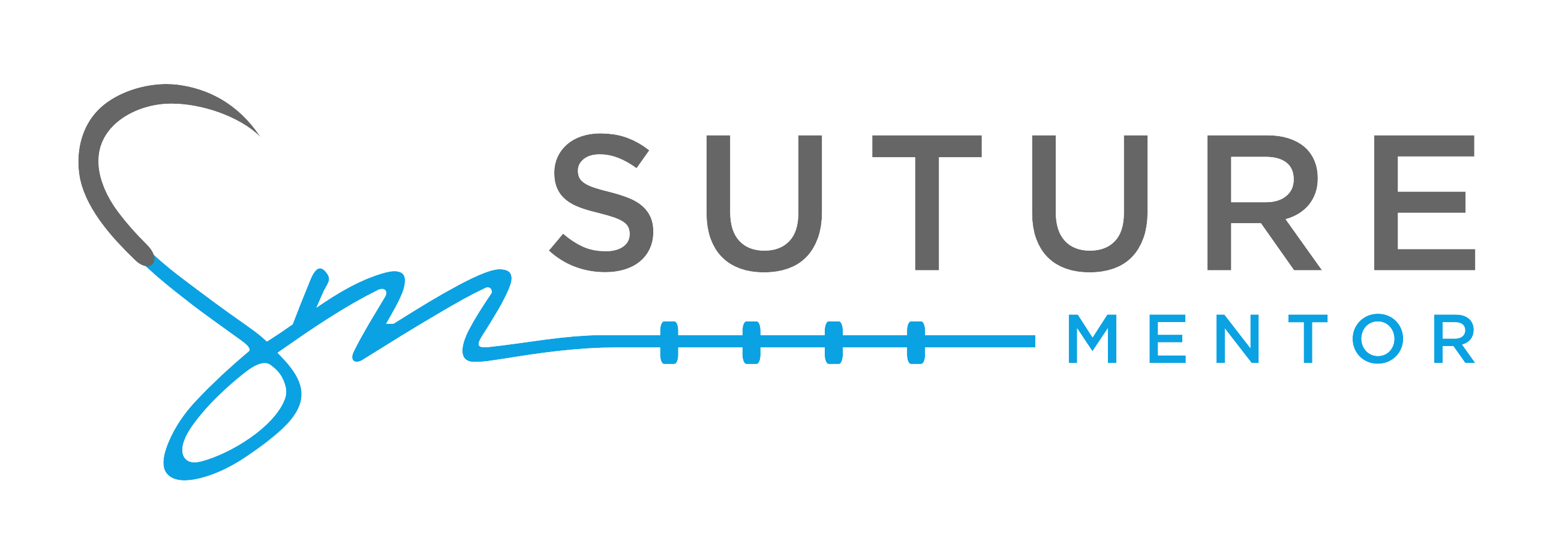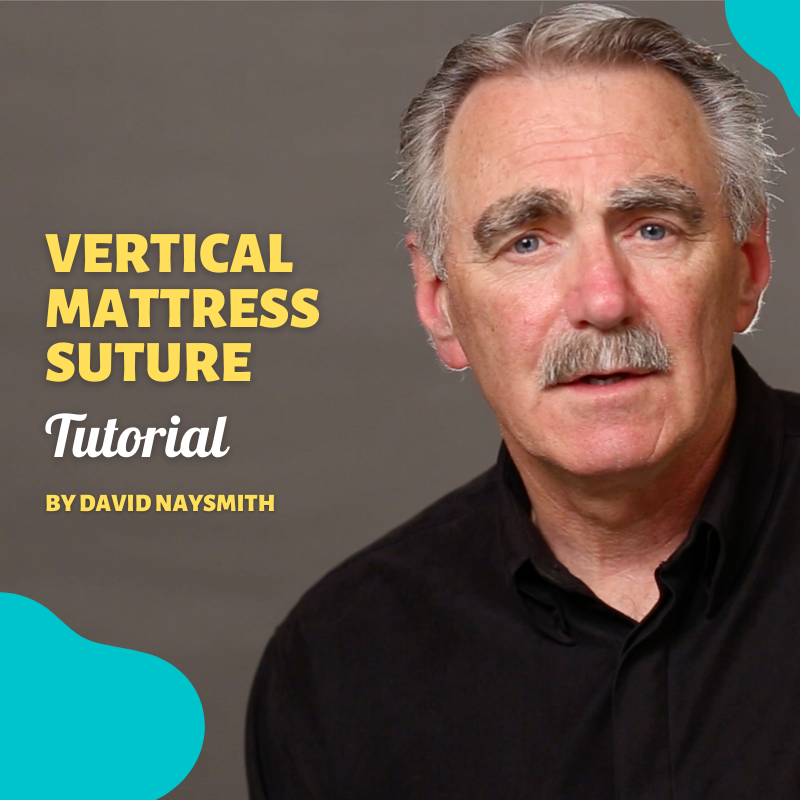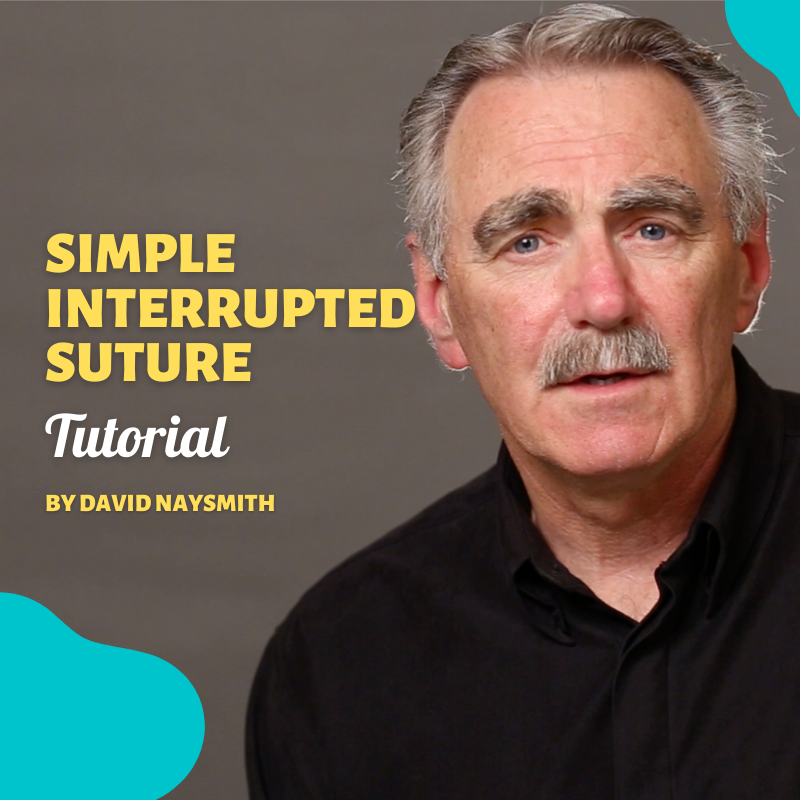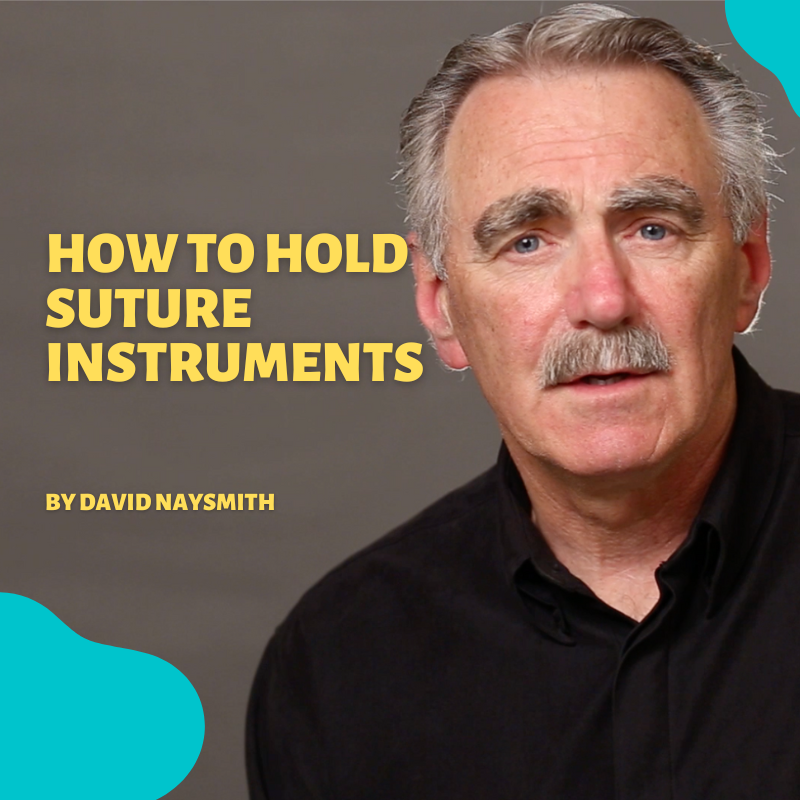Updated February 11, 2023
How to Perform a Vertical Mattress Suture
This tutorial focuses on the technique of placing a vertical mattress stitch in surgery.
The tutorial lists the instruments and supplies needed, which include a needle driver, scissors, a suture, an artificial skin substitute, and toothed forceps. It also explains why a vertical mattress stitch is important and when it should be used. The instructions for placing a vertical mattress stitch are detailed, with step-by-step instructions, illustrations, and tips for success.
This tutorial assumes that you have read and practiced:
- How to hold suture instruments
- How to tie surgical knots with instruments
- Simple interrupted suture guide
PLACING A VERTICAL MATTRESS STITCH
INSTRUMENTS/SUPPLIES REQUIRED

- Needle driver (aka needle holder)
- Scissors
-
A suture on a curved needle
A larger needle will be easier to learn with but any size can be used. And, use a 3-0 or 4-0 suture material – it will be easier to see what is going on. In practice, a vertical mattress stitch can be placed with any size suture.
-
An artificial skin substitute
Pictured is a suture pad from the Suture Mentor Suture Practice Kit.
However, you can also use some heavy felt or the old standby – an orange or banana skin. These are OK for simple interrupted stitches but difficult to use for anything else (i.e. vertical mattress, half-buried horizontal mattress, subcuticular…).
- A toothed forceps
“I already know how to close skin using a simple interrupted stitch. Why should I learn how to place a VERTICAL MATTRESS STITCH?"
In an earlier tutorial you will remember that we discussed requirements for OPTIMAL WOUND HEALING. One of those requirements was “slight eversion of the wound edges”. Occasionally, even with a well-placed simple interrupted stitch, the skin edges will want to INVERT.

This is the indication of a VERTICAL MATTRESS STITCH.
(This is often in areas of thin skin – older patients, the dorsum of the hand or on the forearm.)
Before I go any further let me say that YOU ONLY PLACE A VERTICAL MATTRESS WHEN YOU NEED TO. In other words, if you place one vertical mattress you do not have to make all of the stitches vertical mattress. For example. you can alternate simple interrupted with vertical mattress, or just place a single vertical mattress, as required.
There is some really good news! If you can place a simple interrupted suture then you already have the skills required to place a vertical mattress suture. Why?
Because a vertical mattress stitch is just one simple interrupted stitch stacked vertically over a second simple interrupted stitch. Let’s look at how that is done.
PLACING A VERTICAL MATTRESS STITCH
-
Begin by placing a simple interrupted suture – but don’t tie the knot. (Fig. 3)

Place this first pass a little wider from the wound edges than when placing a simple interrupted. Eg. if you would usually stick the needle in at 3mm from the edge -when starting a vertical mattress stick the needle in at 5mm.
-
Once you have placed this first pass through both sides of the wound TURN THE NEEDLE AROUND ON THE NEEDLE DRIVER.

You will now be sewing BACKHANDED. In other words, if the first pass is going from right to left, then the second pass will be going from left to right.
-
This second pass (going backhanded from left to right) is essentially the beginning of a second simple interrupted that is more superficial but in the same line as the first pass.
- use your forceps to gently pick up the skin and evert it slightly (Fig.5)
- stick the needle through the edge of the skin, taking a small “bite” of the edge (to emphasize that this should be a thin “bite” I often say, “It should be about six cells thick.” The needle passes through the epithelium and then comes out in the superficial dermis.
- pick up the second side with the forceps and gently evert the edge.
- now put the needle through this edge at the same thickness as the first side (i.e. where the needle came out of the superficial dermis)– and passing through the superficial dermis and coming out through the epithelium.
Let’s take a second and see what we’ve done at this point. We have place a simple interrupted stitch going from right to left (without tying it) and then we turned the needle around and place a second, very superficial stitch, going from left to right. We have placed two simple interrupted stitches, one on top of the other.
-
Tie a square knot -just as you do when placing a simple interrupted stitch.
-as you tighten the first knot, watch the skin edges EVERT slightly. As soon as you see the skin edges come together and evert STOP TIGHTENING and place the second and third throws on the knot.
THAT IS IT - a VERTICAL MATTRESS STITCH
TIPS FOR SUCCESS
Avoiding pitfalls that create a less than ideal stitch.
- Make sure the first pass is a little wider than normal for a simple interrupted.
-
Be sure to take a small bite with the second pass of the needle.
- if you do these two things then when the knot is tied you should see a short segment of suture material laying on the skin on either side of the wound edge (the blue arrows).
WHAT CAN GO WRONG?
- If you place the second part of the stitch (the superficial one) to far from the wound edge, or too thick (ie. not “six cells”) then the skin edges with evert so much that the dermis will be exposed. In other words, not epithelium to epithelium touching but deep dermis to deep dermis.
- If you don’t place the first stitch a little wider than normal then the two skin punctures on each side of the wound will be too close together. When you tighten the stitch and tie the knot you will not have “the little line” of suture material on each side of the wound.

- Although the skin edges may evert as you had hoped, the stitch will be almost impossible to remove. Normally this stitch is removed by placing one limb of a scissor under the line of exposed stitch material on the non-knot side of the wound.

That is the VERTICAL MATTRESS SUTURE. Have fun with this technique. Use it only when necessary. Remember, practice makes perfect!
THE SUTURE MENTOR KIT & COMPLETE COURSE
To enhance your learning experience purchase our suture practice kit and online suture course.
It includes all the instruments required, an artificial skin pad, sutures, a cord to practice hand ties, instruction cards, and a unique case that allows you to practice anywhere and that forces you to practice at a correct “surgical distance”.
It includes a case that can be attached that turns the kit into an advanced first aid kit. It comes with seven days of online teaching.
It starts with knot tying and covers instrument ties, hand ties, simple interrupted, vertical mattress, horizontal mattress, half buried horizontal mattress, the “three point” suture for repairing pointed skin edges, deep suture placement with buried knots, running stitches and running subcuticular stitches.
As well, each day’s lesson has several “tips” to make you better at closing wounds. Every lesson has video demonstrations as well as still images to clarify each of the techniques best.
Vertical Mattress Suture Tutorial Video
In this video, Dr. Naysmith covers how to perform a vertical mattress suture stitch.
Purchase the suture practice kit and the complete suture course.
Purchase the full Suturing in 7 Days Course.
Vertical Mattress Suture Transcript
so let's have a look at the vertical mattress suture this is one of the specialty stitch techniques and as i said earlier one wants to be as simple as possible so why would we use this special suture well first of all let's have a look at the simple interrupted on the left hand side this is a simple interrupted and it's a good one why is it a good one it's a good one because the tissues are well opposed and the edges are everted the skin edges poke up on the right hand side this simple interrupted is a poor one why is it poor although the tissues are well approximated the edges are inverted is that a problem for us well you bet it's a problem because we're in the business of trying to make good scar inverted edges will give you a bad scar
so i still haven't answered the question why well this is the vertical mattress have a look at it and the reason why we use vertical mattresses we want to get eversion of the edges those edges need to pop up and sometimes the skin is just so thin it won't do that so the best way to think of it as two simple interrupted stacked one upon the other vertically the first pass is just like a standard simple interrupted perhaps just a little bit wider from the wound edges the second pass we turn the needle around in the needle driver and we sew back handed so we come back picking up just the edge of the skin how much well one of my teachers once said six cells thick that's maybe an overstatement but just the epidermis and the dermis on both sides and then when you tie it what happens is those edges evert up i would use this on the back of the hand for example if the edges want to go in anytime we just need to get eversion so the key points for mattress sutures are think of it as two simple interrupteds stacked one upon the other
on the second pass just pick up the skin edge and no more if you have too much you'll expose dermis the calmness mistake is not having enough distance between the passes on each side and what do i mean by that i mean these two areas need to be separated a little bit or you won't be able to see the stitch to take it out it's a great stitch and there's lots of indications for use
so let's practice this now on the foam pad make an incision in the foam pad and then just remember what we're doing is replacing two simple interrupteds great simple interrupted my wrist rotated well back i'm going to come through and make the pass all the way through on both sides with one pass pull the stitch in through turn the needle around in the needle driver because we're going to be coming back in a backhanded fashion here pick up just the edge in this case it'll be the beige representing the epidermis and maybe a little bit of the red of the dermis pop it through
you can see we've separated each of the sides as i mentioned so we can see some of the stitch still to take it out and when we tie it up this everts the edges beautifully
lovely e version you can see enough of the stitches to be able to take that out as well we'll talk about how to remove these when we talk about suture removal let's have a look at it again
the first is a simple interrupted
roll the needle all the way through work with the curve of the needle
turn the needle around so we can sew backhanded
pick up just the edge
now what's the difference between these two you can see i haven't separated the two stitches on one side this is going to be a tough stitch to take out we don't want to do that you want to do it as we did in the first pass where you see enough stitch you can get it out that's an easy one the bottom one's going to be very difficult okay let's have a look and see what this looks like on real skin
i'm going to make one pass on one side one on the other rather than going all the way through tissues are separated a little bit notice the distance that i'm coming out a little further than you would normally go with the simple interrupted but it is a simple interrupted backhand the needle come back just the skin edge and that's all
six cells well maybe that's an overstatement but it's thin and then when you tie it together watch as the skin edges just ever beautifully just enough tension just to get them up don't overdo it
and there you can see the edges come up nicely this is a terrific stitch when it's needed the vertical mattress





Leave a comment
All comments are moderated before being published.
This site is protected by hCaptcha and the hCaptcha Privacy Policy and Terms of Service apply.